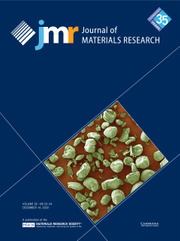Crossref Citations
This article has been cited by the following publications. This list is generated based on data provided by
Crossref.
Munier, A
Schaller, R
Mercier, O
and
Waeber, WB
1993.
Radiation Embrittlement of Nuclear Reactor Pressure Vessel Steels: An International Review (Fourth Volume).
p.
269.
Bao, Yingbin
and
Wierzbicki, Tomasz
2004.
A Comparative Study on Various Ductile Crack Formation Criteria.
Journal of Engineering Materials and Technology,
Vol. 126,
Issue. 3,
p.
314.
Bao, Yingbin
and
Wierzbicki, Tomasz
2005.
On the cut-off value of negative triaxiality for fracture.
Engineering Fracture Mechanics,
Vol. 72,
Issue. 7,
p.
1049.
Teng, X.
and
Wierzbicki, T.
2005.
Numerical study on crack propagation in high velocity perforation.
Computers & Structures,
Vol. 83,
Issue. 12-13,
p.
989.
Varyukhin, V. N.
and
Efros, B. M.
2006.
Nanostructured Materials by High-Pressure Severe Plastic Deformation.
Vol. 212,
Issue. ,
p.
13.
Beygelzimer, Ya. E.
Prokof’eva, O. V.
and
Varyukhin, V. N.
2006.
Structural changes in metals subjected to direct or twist extrusion: Mathematical simulation.
Russian Metallurgy (Metally),
Vol. 2006,
Issue. 1,
p.
25.
Ghosh, A.K.
2008.
Analysis of the interpretation of yielding and strengthening behavior in small-size samples.
Acta Materialia,
Vol. 56,
Issue. 10,
p.
2353.
Autenrieth, Hermann
Schulze, Volker
Herzig, Norman
and
Meyer, Lothar W.
2009.
Ductile failure model for the description of AISI 1045 behavior under different loading conditions.
Mechanics of Time-Dependent Materials,
Vol. 13,
Issue. 3,
p.
215.
Wu, P.D.
Embury, J.D.
Lloyd, D.J.
Huang, Y.
and
Neale, K.W.
2009.
Effects of superimposed hydrostatic pressure on sheet metal formability.
International Journal of Plasticity,
Vol. 25,
Issue. 9,
p.
1711.
XUE, LIANG
and
WIERZBICKI, TOMASZ
2009.
DUCTILE FRACTURE CHARACTERIZATION OF ALUMINUM ALLOY 2024-T351 USING DAMAGE PLASTICITY THEORY.
International Journal of Applied Mechanics,
Vol. 01,
Issue. 02,
p.
267.
Peng, J.
Wu, P.D.
Huang, Y.
Chen, X.X.
Lloyd, D.J.
Embury, J.D.
and
Neale, K.W.
2009.
Effects of superimposed hydrostatic pressure on fracture in round bars under tension.
International Journal of Solids and Structures,
Vol. 46,
Issue. 20,
p.
3741.
Huang, Hongcheng
and
Xue, Liang
2009.
Prediction of slant ductile fracture using damage plasticity theory.
International Journal of Pressure Vessels and Piping,
Vol. 86,
Issue. 5,
p.
319.
Xue, Liang
2009.
Stress based fracture envelope for damage plastic solids.
Engineering Fracture Mechanics,
Vol. 76,
Issue. 3,
p.
419.
Wu, P.D.
Chen, X.X.
Lloyd, D.J.
and
Embury, J.D.
2010.
Effects of superimposed hydrostatic pressure on fracture in sheet metals under tension.
International Journal of Mechanical Sciences,
Vol. 52,
Issue. 2,
p.
236.
Childs, Thomas HC
2012.
Developments in Simulating Built up Edge Formation in Steel Machining.
Procedia CIRP,
Vol. 1,
Issue. ,
p.
78.
Khan, Akhtar S.
and
Liu, Haowen
2012.
Strain rate and temperature dependent fracture criteria for isotropic and anisotropic metals.
International Journal of Plasticity,
Vol. 37,
Issue. ,
p.
1.
Khan, Akhtar S.
and
Liu, Haowen
2012.
A new approach for ductile fracture prediction on Al 2024-T351 alloy.
International Journal of Plasticity,
Vol. 35,
Issue. ,
p.
1.
Li, Feng
Zhang, Xin Long
and
Shi, Wei
2013.
Deformation Behavior in the Uniaxial Tension Process of Aluminum and Aluminum Alloy Sheets under Fluid Pressure.
JOM,
Vol. 65,
Issue. 5,
p.
604.
Lou, Yanshan
and
Huh, Hoon
2013.
Extension of a shear-controlled ductile fracture model considering the stress triaxiality and the Lode parameter.
International Journal of Solids and Structures,
Vol. 50,
Issue. 2,
p.
447.
Lou, Yanshan
and
Huh, Hoon
2013.
Prediction of ductile fracture for advanced high strength steel with a new criterion: Experiments and simulation.
Journal of Materials Processing Technology,
Vol. 213,
Issue. 8,
p.
1284.

